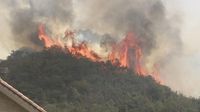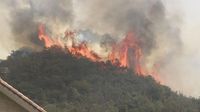As emergency responders battle a persistent mountain fire in Okayama City’s South Ward, residents are facing growing concerns as the situation escalates. The latest updates, provided by the city on March 25, 2025, confirm that the fire continues to spread eastward and southward, posing increasing risks to local communities.
The fire ignited in the afternoon on March 23 and was met with swift action from local authorities. Okayama City issued its first evacuation order for the Fukuda and Miyawaki areas at 8:45 PM that evening, aiming to ensure the safety of residents. However, as the fire intensified, further evacuations became necessary. As of March 25 at 7:50 PM, an evacuation order affected approximately 627 households and 1,146 individuals in the Kozukushi and Aotsu areas of Minami Ward. Additionally, Tamano City took action as well, ordering evacuations for 464 households, encompassing 987 people in Banda and Kitakata.
Reflecting on the firefighting efforts, Okayama City reported that by 4 PM on March 24, the situation appeared to improve, with officials stating that fire spread was being suppressed. An evacuation order put in place shortly after the initial outbreak was lifted later that day at 5:30 PM, offering a glimmer of hope. However, the respite was short-lived. On March 25 at 9 AM, it was revealed that the fire's impact had expanded to 300 hectares, increasing to 311 hectares by 1 PM.
As officials tracked the fire's progress, they noted that firefighting efforts included both ground and aerial units working tirelessly to contain the flames. The Kojima Bay Bridge, a critical thoroughfare in the region, has been closed to all traffic since 5:30 PM on March 25 due to the fire, with no immediate plans for reopening. This closure has heightened concerns among residents and commuters alike, as they face disruptions and potential evacuation.
The city has been proactive in communicating with the public about the ongoing hazards, emphasizing that, while efforts are focused on suppressing the fire, the potential for further evacuation orders and road closures remains high if the conditions do not improve.
As of March 26 at 7 AM, an official report indicated that the fire continues to spread eastward, forcing local authorities to remain on high alert. Firefighting teams from the city, including firefighters and emergency services, have been engaged in extensive aerial operations in an attempt to combat the blaze effectively.
The urgency of the situation is echoed in various communications from the city administration, reiterating that public safety is the top priority amid the unfolding crisis. The government has also escalated its response to the ongoing fires in Okayama and the wider region with a governmental task force designed to coordinate resources and ensure the safety of affected residents. By 9:21 AM, it was noted that various levels of government are rallying together to provide comprehensive support.
Despite these focused efforts, residents remain anxious. The combination of evacuations, traffic disruptions, and uncertainty around when normal operations can resume weighs heavily on local communities. In particular, the cancellation of scheduled events, such as sporting matches, underscores how significantly the fire is impacting daily life.
The situation in Okayama City spotlights not just the immediate threat posed by environmental disasters but highlights the broader vulnerabilities faced by communities during such crises. With each passing hour, local leaders stress the need for ongoing vigilance, providing continued updates to residents regarding both the fire's progression and responses by emergency services.
Amidst concerns about the resilience of local infrastructures and the ability to safeguard communities against such natural disasters, environmental advocates call for an urgent review of fire prevention strategies and community preparedness initiatives. The unforeseen escalation in the scale of the fire and the urgency with which local authorities reacted serves as a stark reminder of the imperative of effective disaster management.
As firefighting operations continue and the recovery from this incident is assessed, residents cling to the hope that robust measures will keep their communities safe while addressing the broader implications of fire safety in the region. As of now, the challenge remains formidable, with officials navigating both the immediate logistical requirements of firefighting and the longer-term considerations of community resilience.
The increasing threats of climate-linked disasters, exemplified by this fire, raise critical questions about preparedness, response, and recovery for communities subject to such unpredictable hazards. The implications of this fire extend beyond Okayama City, igniting discussions about the need for collaborative efforts in disaster management across the country.
As we continue to follow the situation, it will be essential to remain informed about developments concerning the fire, ongoing evacuations, and the health and safety of those affected.







